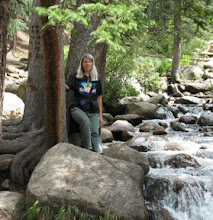 On Saturday (10/22), I saw my first coyote in quite some time.* Up close and personal, he stood behind my car as I was leaving the office at 9:30 a.m. Big, beautiful, and apparently bold, he looked back at me from the rear-view mirror, then calmly ambled off to watch me from a different angle before disappearing in the brush along the creek. (Yes, our office location is really neat!)
On Saturday (10/22), I saw my first coyote in quite some time.* Up close and personal, he stood behind my car as I was leaving the office at 9:30 a.m. Big, beautiful, and apparently bold, he looked back at me from the rear-view mirror, then calmly ambled off to watch me from a different angle before disappearing in the brush along the creek. (Yes, our office location is really neat!)The camera was there, but wildlife photographer I'm not, so it didn't cross my mind until later. We'll have to make do with my old illustration. Unfortunately, it also didn't occur to me to do more than quietly observe him!
If my haphazard blogging can be trusted, it's been almost three years since we've seen coyotes around the homestead, 3.5 since we've lost a cat to one, and only in April 2004, I think it was, did we lose chickens to them. With the cats we're never sure; they just disappear and we make assumptions. (But other possible culprits include great horned owls, foxes, and maybe even mountain lions.) The chicken event (15 chickens dead and dying in one afternoon) provided direct visual confirmation of the perpetrator.
But my sighting Saturday turned out to be timely. The day before, Cat Woman lost her cat and heard from a neighbor that there was a big coyote in her area. Putting one and one together, she found the sad evidence, confirming the cat's fate. In her rural area, residents routinely kill coyotes, so she didn't expect one; she worries more about mountain lions.
The week before, my sister—far down in the southwest corner of the state—also lost a cat. Suddenly, coyotes are back on my mind, and apparently, back in business.
Coyotes have had a lot of press lately in the Denver metro area; this recent article serves as an example of the concerns and the lethal response too often being applied locally. (Although, in California, one neighborhood is taking a less belligerent approach.)
 They are truly our urban/suburban wild dog: we provide excellent habitat for them and have created a new breed of this canine with the wily reputation. Eons ago in grad school, I researched coyotes for a wildlife class, and learned that there was evidence that, when persecuted, coyotes produce larger litters, and also grow smarter, stronger, and faster. Killing them isn't necessarily going to help! Nature... vacuum... you get the drift.
They are truly our urban/suburban wild dog: we provide excellent habitat for them and have created a new breed of this canine with the wily reputation. Eons ago in grad school, I researched coyotes for a wildlife class, and learned that there was evidence that, when persecuted, coyotes produce larger litters, and also grow smarter, stronger, and faster. Killing them isn't necessarily going to help! Nature... vacuum... you get the drift.With decreasing wild land for habitat, coyotes have been quick to learn to live with us. They have to—after all, we're everywhere these days! We have not been as quick to learn to live with them. Some people don't understand the concept of "wild" and insist on feeding whatever cute animals they see in parks or neighborhoods. That doesn't help, especially when dealing with medium-size predators.
Denver has posted lots of information online to help citizens learn appropriate behaviors toward wildlife in the city.** In the case of coyotes, active hazing programs are important to teach them appropriate behaviors toward humans. Now I have a better idea of what to do when I see one—for the coyote's sake!
More personal thoughts on living with predators over at Small Wonders.
Two more coincidences. * Actually my previous recent coyote sighting was when I flew back from Indiana, just a week before this sighting. Carl the Coyote was the whole 'nother animal that graced the tail of my Frontier jet.
** Thanks go out to Ashley DeLaup, wildlife specialist for the City of Denver, who created all that great material I linked to above and conducted educational programs for Denver's citizens. This fall, Ashley was laid off. Go figure.



















































